Private, 6/348, Joseph Unwin, 2nd Battalion Rifle Brigade
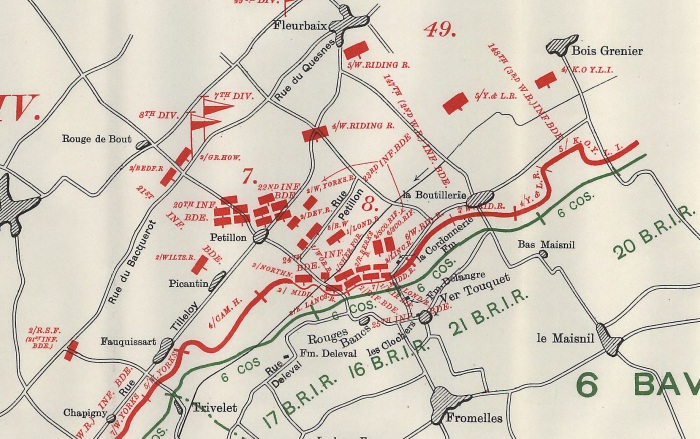
The order of battle for the 7th Division on 9th May 1915
Today is the 102nd Anniversary of the the Battle of Aubers Ridge and this is the story of a man from Worsead who was killed in action in the battle.
Joseph Unwin was born in Enfield, Middlesex in 1891 and was the youngest son of Henry and Caroline Unwin who had two other sons, Henry and Alfred and two daughters, Martha and Edith. He married Emma Louisa Woodhouse in 1912 and at the start of the Great War both were residing at Meeting Hill, which is a small hamlet to the North West of Worstead. His trade is listed as being a chauffeur. Joseph is not recorded on the war memorial in the church but he is listed as being a Worstead man in the Norfolk Roll of Honour.
The 2nd Battalion Rifle Brigade had landed in France on 6th November 1914, along with the rest of the 25th Brigade, which was part of the 8th Division. They had been a much needed re-enforcement for 1st Ypres. They would then learn their newfound craft in the trenches over the winter of 1915/15, a time, which would become known as the ‘Winter Operations’. During this phase men were lost to snipers and mining activity. They had to rapidly adapt to trench warfare where one mistake could mean instant death and their conditions were terrible They were constantly low on drafts of replacements and supplies and would be forced to carry out a number of initial battles which would not be able to break the German lines due to them being without support and because they would be fought as small engagements and it is in one of these that Joseph would lose his life.
While the BEF were engaged in learning their craft in the winter of 1914/15, the Central Powers had turned their attention to the Russian Front and a series of battles had been fought there. This led the Allied Powers to believe that the Germans were planning the same for the spring of 1915 and with that in mind they believed that the Germans were to make reductions of their forces on the Western Front.
The Allies felt that an attack there whilst their foe was weak in reserves would also serve the purpose of supporting the Russians because if they capitulated it would mean the Germans would be able to direct all their forces against the Western Front.
In early March 1915, Sir John French agreed to commit troops to a plan put forward by General Joseph Joffre. This would be a joint British and French offensive to capture the heights of Aubers Ridge, which stretched for 6 miles behind the small towns of Aubers and Fromelles. The first of these offensives occurred on 10th March when French ordered General Sir Douglas Haig, the then commander of the British 1st Army, to attack the Germans along a 2 mile front opposite the French town of Neuve Chapelle. Haig used 4 divisions to break through a line held by a division of the German 6th Army. But the total gain, for three days of terrible fighting, amounted to a piece of French soil 2,000 yards wide and 1,200 yards deep. All this at the cost of 11,000 British and Indian troops.
The Germans quickly counter-attacked, and although Neuve Chapelle was held, Haig had to abandon plans to advance towards Aubers Ridge. At the end of the offensive, the British Expeditionary Force had only gained 1.5 square miles of land at a cost of 13,000 casualties. The Allies went back to the planning table and Joffre asked French whether he could commit troops to a joint attack where it was planned to capture the Douai and Aubers Ridges, John French agreed. The plan can be summarised by a communiqué from Joffre to French.
‘In the last days of April the French Tenth Army, will undertake an important attack north of Arras with a view to piercing the enemy’s line. In order to carry out this attack the Tenth Army will be strongly reinforced, it will consist of fourteen infantry divisions (exclusive of Territorial divisions) and about 220 heavy guns and more than 720 field guns and howitzers.’
From: France and Belgium 1915.Vol II: Battles of Aubers Ridge, Festubert, and Loos. OFFICIAL HISTORY OF THE GREAT WAR.
The French 10th Army would attack to the right of the British who held a frontage of four miles with the II Cavalry Corps to be held in reserve. They would attack Vimy Ridge between Farbus and Souchez. If successful the French would be able to capture the dominating heights of Vimy and allow them to sweep into the Cambrai-Douai Plain. Three diversionary attacks would also be implemented.
French informed Joffre on the 9th April that the British 1st Army would have the task of attacking the Germans the day after the main attack had gone in. This would be in conjunction with the final French diversionary attack. The British would centre on the area towards Aubers Ridge and La Bassée. French committed the 1st British and the Indian Corps to attack the Festubert/Neuve Chapelle line and the British IV Corps would have the job of attacking the Aubers-Fromelles line. They would have the job of consolidating the French gains and would prevent the Germans pouring in reserves.
However, the Germans struck first at Ypres on the 22nd April, utilising gas, which was the first time it was ever used in any offensive. In this battle the Germans very nearly overran the Allies, but the Canadian troops managed to hold the line, the first time a Colonial power had ever done this. Amazingly this German strike did not faze Joffre who continued his plans for the joint British and French offensive. Joffre was of a mind that a carefully planned offensive would help to relieve the pressure from the German attacks in the north.
On 4th May 1915 John French issued this order to the 1st Army:
‘The First Army will take the offensive on 8th May. Its mission is to break through the enemy’s line on its front and gain the La Bassée-Lille road between La Bassée and Fournes. Its further advance will be directed on the line Bauvin-Don. The Cavalry Corps, Indian Cavalry Corps, Canadian Division, Highland (51st) Division (less one brigade R.F.A.) and Northumbrian (50th) Division will be in general reserve at the disposal of the Field Marshall, Commanding in Chief, and will be ready to move at two hours notice.’
From: OFFICIAL HISTORY OF THE GREAT WAR, France and Belgium 1915.Vol II: Battles of Aubers Ridge, Festubert, and Loos.
With this in mind, the respective units took over the line in preparation for the forthcoming attack with the 8th Division being given a frontage of 1,500 yards opposite the Sailly-Fromelles Road and would face the German 6th Bavarian Reserve Division. The plan for Aubers Ridge was for the 1st Army to make a two-pronged attack on the German line that ran from just south of Neuve Chapelle to Bois Grenier.
The southern sector consisted of the Indian and 1st Corps who had the job of capturing Aubers Ridge itself. IV Corps, 6,000 yards to the north, had the task of capturing Fromelles.
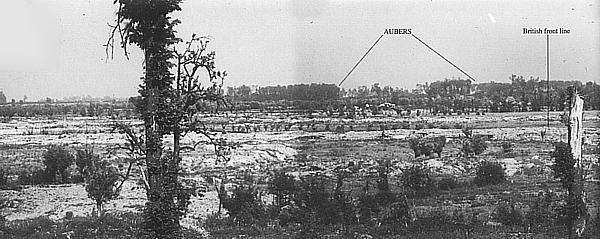
The left hand aspect of the area for 9th May 1915
But the biggest problem at this time was the shortage of artillery and shells. The French intended to adopt a slow and methodical bombardment of the German trenches in their sectors, the British could not hope to match this and decided on a 40-minute intense bombardment like the one used at Neuve Chapelle. This had been quite successful and had led to the Germans being unable to hold their own lines due to insufficient defences. But the Germans had learnt from their mistakes and had worked tirelessly to strengthen their defences. This would prove to be a major point of fact as to how the battle would progress.
The 8th Division would attack with the 24th Brigade on the right and the 25th to the left; both brigades totalled around 7,000 officers and men. The Official History of WWI estimates that around ten German companies would be facing them, a total of around 1,600 men. The plan was for both brigades to rush the German front-line before pushing on to enlarge the front and protect the area. The 7th Division would advance close behind the 8th and then capture Aubers and Leclercq Farm. It was then hoped that both divisions would be able to further advance capturing Aubers Ridge and protecting the left flank in order that the 7th Division could eventually meet up with the Indian Corps at La Cliqueterie Farm.
We now turn to the 2/Rifle Brigade’s war diary for May 1915. They had been in and out of the line around Laventie since the beginning of May. There is no mention of any training being carried out for this forthcoming action and the first mention of their participation comes on 6th May when company officers were sent up to the line to reconnoitre the area and orders were passed for operations.
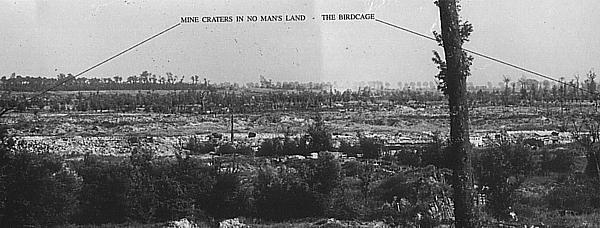
The right hand aspect of the battle area for 9th May 1915
What is strange is that there is no build up to this battle for the 2/Rifle Brigade. They rested in their billets on the 7th and 8th May and were only paraded for the forthcoming attack at 11.00 p.m. and then marched off to their assembly positions. This movement went without incident with the war diary stating,
‘Instructions and orders for assault & the first advance were issued & were accurately carried out.’
The weather on this day is recorded as being fine, clear and fresh with sunrise at 04:06hrs This was shattered at 05:00hrs by the start of the 40 minute bombardment from 102 guns that had the task of either cutting the German wire or destroying the German positions. Unfortunately some of this fell short and the artillery began to shell their own lines, of which the 2/Rifle Brigade took the brunt of this fire and men were either killed or wounded before even getting out of their trenches, or were forced to retire from their start points. This retirement was stopped and at 05:40hrs the first waves of men climbed out of their trenches and moved towards the German lines.
The 25th Infantry Brigade’s frontage stretched from the main Sailly/Fromelles Road across fields towards La Cordonnerie Farm. The 2/Rifle Brigade faced Rouge Bancs. B & D Companies had been given the task of advancing in the first wave, with C & D Companies, the Machine Guns and RHQ following behind. B & D took the first German trench and continued their advance.
However, the follow up waves took heavy casualties from German fire and could not advance any further than the German front-line, with many of the units being dispersed, including the bombing parties who were to be used to widen the advance. B & D Companies managed to capture a number Germans and pushed on a further 250 yards.
Here they managed to make a line and at this point consolidated the position and they organised bombing parties, where bombs and bombers could be found, and defended 50 yards to the Sailly-Fromelles Road to the 250 yards of German line already mentioned. This places them just in front of where the Australian Memorial is situated today. At this point in time, every officer in the most forward position was either dead or wounded. At around 8.00 a.m. the men who still held this position began to trickle back to the original German line and reported the forward elements were taking fire from the flank and from the rear.
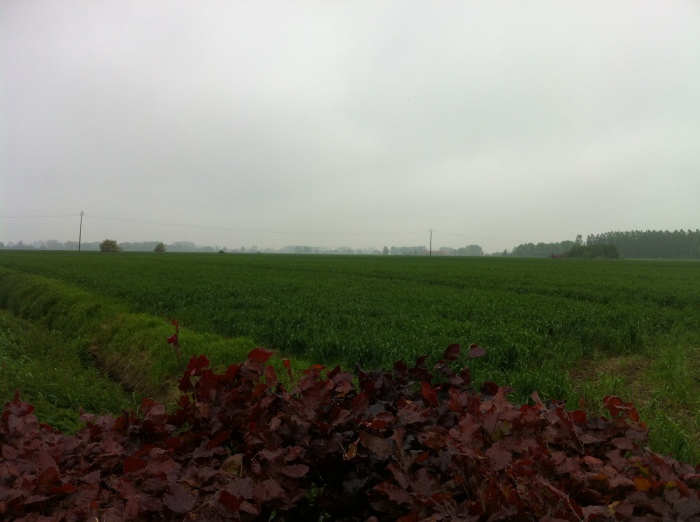
Looking out towards where the 2/Rifle Brigade advanced on 9th May 1915
The German front line was then strengthened and an attempt to bomb the 2/Rifle Brigade out of this position was repelled. At 12 noon Lt GRAY led a party of 50 men from the British front-line to the German line. By now the whole area was being swept with German machine gun fire and only 20 men reached the German line.
At this point in time, only 3 other battalions had successfully reached the German lines. These were the 2/Northamptonshire Regiment, the 1/Royal Irish Rifles and the 1/13th London Regiment. All had advanced with the 2/Rifle Brigade. The 1/13th London’s had been assisted by two mines which had been fired at 05.40 a.m. and they had occupied the craters. But all other movement either by the 24th Brigade or the 23rd Brigade who were to follow up was stopped after the 24th Brigade found the German wire uncut and took heavy casualties there.
This initial success, followed by failure in other areas prompted the brigade commander, Brigadier General Lowry Cole to go to the front-line. He found all movement stopped and no man’s land being swept with machine gun fire. He ordered two companies of the 2/Lincolns to use the mine craters to get to the 2/Rifle Brigade and shortly after this a large number of Rifle Brigade and Irish Rifles men were seen to be streaming back to the British lines bringing with them the two companies of 2/Lincolns. To add to the confusion, large numbers of German prisoners came too leading the British to believe a counter attack was taking place. Lowry Cole stood on the parapet in an attempt to stem this tide and fell mortally wounded. This goes to show that not every senior officer in France spent his time well away from the front; in fact during the course of WWI well over 60 senior officers were killed in action.
This fact was noted in the 2/Rifle Brigade’s war diary noting that their C.O., Lieutenant Colonel R B Stephens, had become the acting brigade commander. It was also at this point in time that the forward units became cut off.
‘The British front and communication trenches, converted almost into obstacles by the remains of broken ladders and light bridges, were blocked with dead, wounded and leaderless men, the congestion being constantly increased by the endeavours of the rearmost waves to reach the front. Movement forward, rearward or lateral became impossible, except over the open, and the Germans in the unattacked portions of the front were able to prevent not only substantial support, but even individuals from crossing no man’s land. It was clear that the men who had formed the lodgements were cut off.’
From: OFFICIAL HISTORY OF THE GREAT WAR, France and Belgium 1915.Vol II: Battles of Aubers Ridge, Festubert, and Loos.
The men of the 2/Rifle Brigade, along with all the other battalions who now held a small piece of German line could have had no idea that any of this was going on. They put up obstacles to repel any German attacks and consolidated what little they had captured. At this point in time it became very apparent to the commanders on the ground that no further movement could be made.
Haig was told of this fact and in light of the fact that the 1st and Indian Corps attack had failed and the need to assist the French who were attacking he ordered the 8th Division to renew the attacks. A fresh bombardment was ordered and what was left of the 23rd and 24th Brigades was readied for a new attack.
The attack went in a 1.30 p.m. and failed almost immediately when the leading waves were hit with furious fire. In fact, it is noted by the Official History of the Great War that the attack was stopped even before it got under way. Haig ordered fresh attacks and put other brigades at the disposal of the 8th Division, but by 8.00 p.m. these new attacks were cancelled and Haig ordered his commanders to the Indian Corps H.Q.
After the battle it was noted,
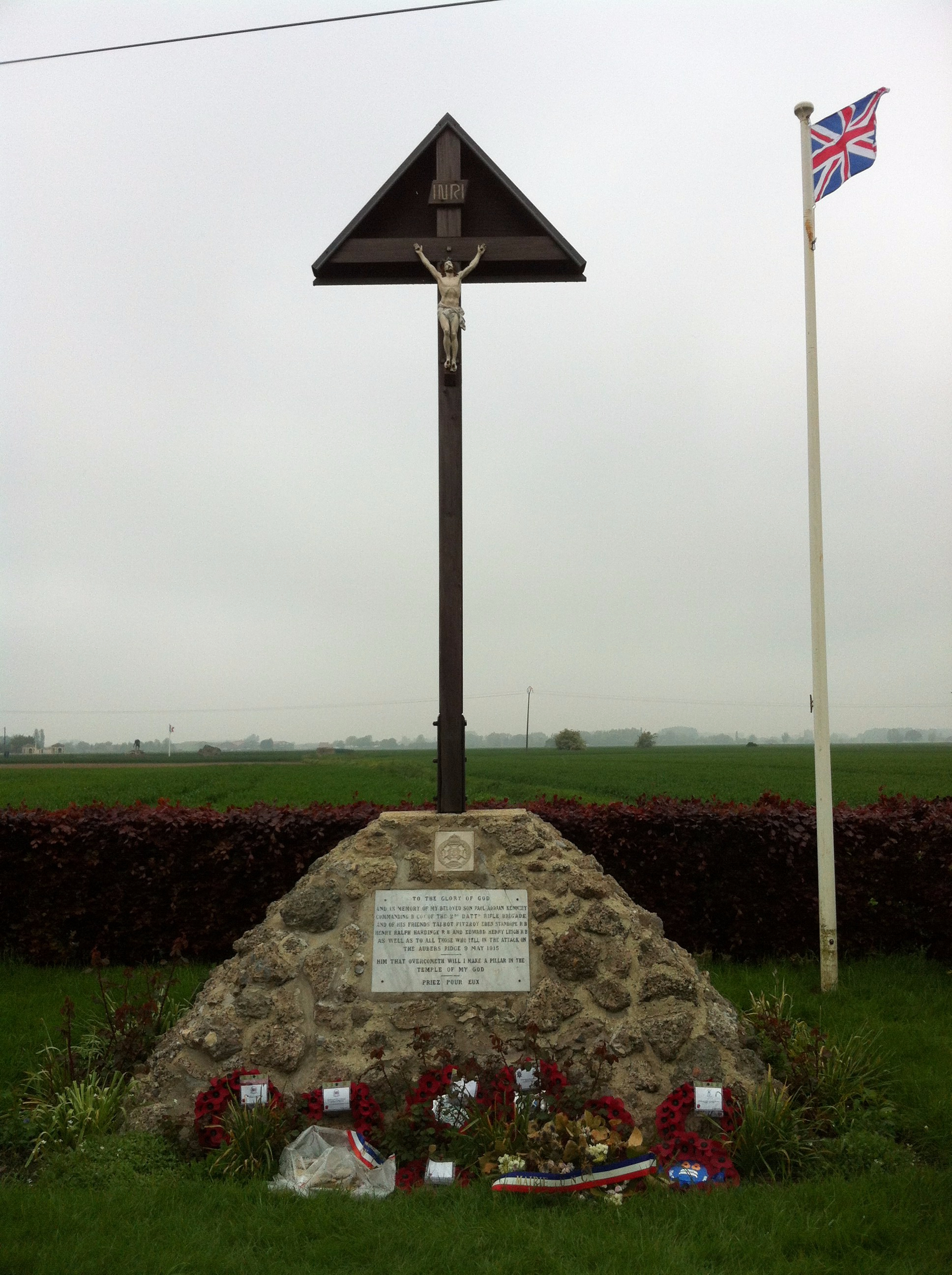
The memorial to Paul Adrian Kennedy and his friends which now stands on the battlefield where the 2/Rifle Brigade fought at Aubers Ridge.
‘Throughout the 9th and 10th repeated efforts were made to make further progress. Not only was this found to be impossible, but the violence of the enemy’s machine-gun fire from his posts on the flanks rendered the captured trenches so difficult to hold that all the units of the 4th Corps had to retire to their original position by the morning of the 10th.’
From Sir John French’s 8th Despatch printed in the Second Supplement to the London Gazette of 10th July 1915.
Between 07:50hrs and 15:00hrs the 2/Rifle Brigade fought off two determined German counter attacks. Their war diary notes that their machine gun detachment acted gallantly and caused heavy losses to the Germans. They, along with all the other units, managed to hold onto their gains all through the night and some reinforcements managed to get to them during that period. However, at 2.30 p.m. on 10th May 1915, the Germans launched a strong counter attack and all survivors of the advance were withdrawn. By now this only totalled some two hundred men. The last battalion to stay in the German lines, the 1/13th London’s, were reinforced by the 2/Royal Berkshires and the 2/Lincolnshires, but they were insufficient in numbers to hold onto the German lines and by 15:00hrs all British units were back in their trenches.
‘About 5 a.m. the battalion, consisting of 3 officers and about 195 men marched back to billets near SAILLY.’
From the war diary of the 2nd Battalion Rifle Brigade.
In total the 8th Division lost 192 Officers and 4,490 Other Ranks, the highest number that any division lost in this ill-fated offensive. The 2/Rifle Brigade lost 21 Officers and 632 Other Ranks. Of this total 18 Officers and 244 Other Ranks were either killed in action or died of wounds soon after. Joseph Unwin was one of the men who were killed in action and he has no known grave, as do many of the others who fell on the 9th May 1915.
There is a memorial that stands in memory of Captain Paul Adrian Kennedy who was attached to the battalion. He was killed in action in the attack and the memorial commemorates his sacrifice and remembers his 3 comrades in arms. They are Lieutenants Talbot Stanhope and Edward Leigh, and Second Lieutenant the Honourable Henry Hardinge. None of them have no known graves and along with Joseph Unwin are commemorated on Panel 10 of the Ploegsteert Memorial in Belgium.
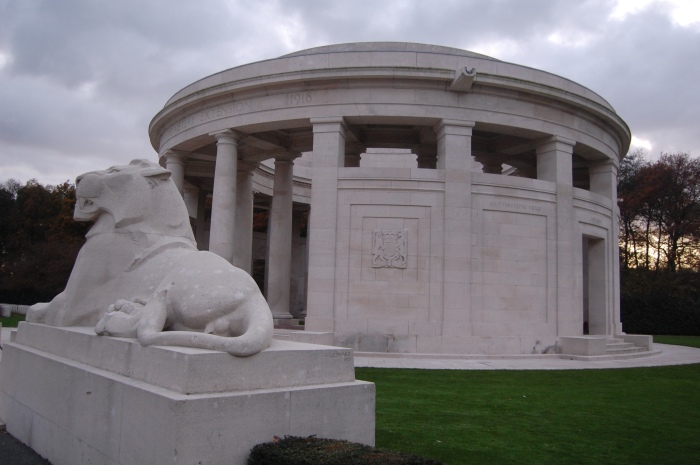
The Ploegsteert Memorial
